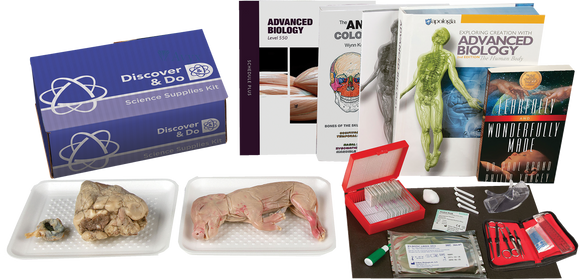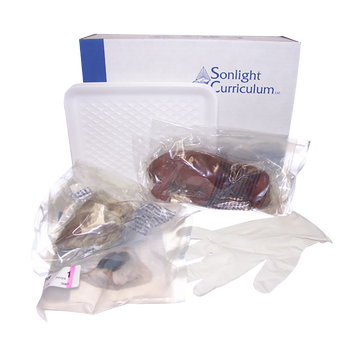Prerequisites: Biology 250 and Chemistry 350
Combine this Advanced Biology 550 course with Biology 250 to give your student the equivalent of a university biology course.
Put another way: these two courses together cover the entire Advanced Placement (AP) curriculum. (Note: Advanced Placement, Advanced Placement Program, and AP are registered trademarks of the College Board, which was not involved in the production of, and does not endorse, this product.)
This Advanced Biology course covers both the anatomy and the physiology of the human body's 11 organ systems in detail.
Please Note: the reproductive system is covered in detail, including frank (not pornographic) illustrations and descriptions.
The textbook is hardbound. It is the student text, which contains all student material, on-your-own questions and solutions, laboratory exercises, and chapter study guides. It has color illustrations and diagrams.
The answer key is softbound. It is the solutions and tests manual, which contains answers to chapter study guides, tests, and test solutions. It is black-and-white.
Advanced Biology Contains Three Kinds of Labs
Microscope Labs
Requires a microscope (not included) and special prepared slides (included). The included prepared slide kit has 14 slides:
- Human blood smear
- Human bone tissue
- Human cerebrum
- Human liver tissue
- Human lung
- Human red bone marrow
- Human salivary gland
- Human skin
- Human skin w/t.s. hairs
- Human spermatozoa
- Human stomach
- Human striated muscle
- Human testis
- Human tonsil w/lymph nodes
Dissection Labs
Requires a dissection tool kit (included) and Advanced Biology Dissection Animals (included).
This item includes:
- Cow Eye
- Sheep Heart
- Fetal Pig - double injected (arteries- red, veins-blue)
- 3 disposable dissection trays
Coloring Book Exercises (included: 550-14 - anatomy coloring book)
These are probably the most important "lab" exercises for the student to perform. There is a lot to memorize in this course, and the coloring book will help the student quite a bit. This is NOT a juvenile coloring book. It is the same coloring book used in many university Anatomy and Physiology courses.
This learning tool teaches anatomical concepts and illustrates all the structures and systems of the body through coloring exercises, an effective teaching device that also aids in the retention of the material. Detailed illustrations are organized according to body system and a color-key system links terminology to illustrations, reinforcing learning and impressing upon students the visual details of anatomy.
This guide to human anatomy and physiology provides a visual study of the diverse organs and systems of the human body and how they work.
Prerequisite: Students need to have successfully completed one year each of high school biology (such as the first-year Biology program, #250) and chemistry (such as the first-year Chemistry program, #350) before taking this advanced biology course.



